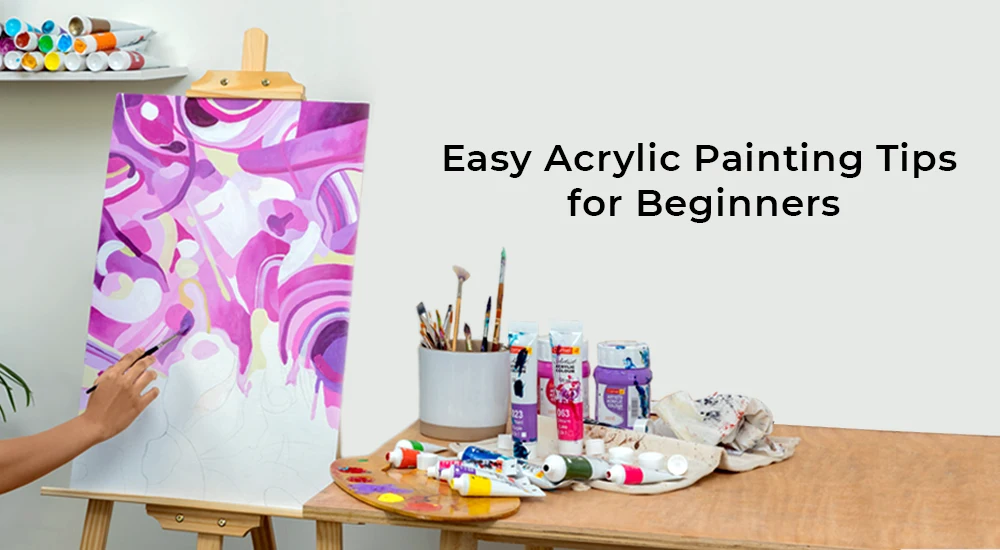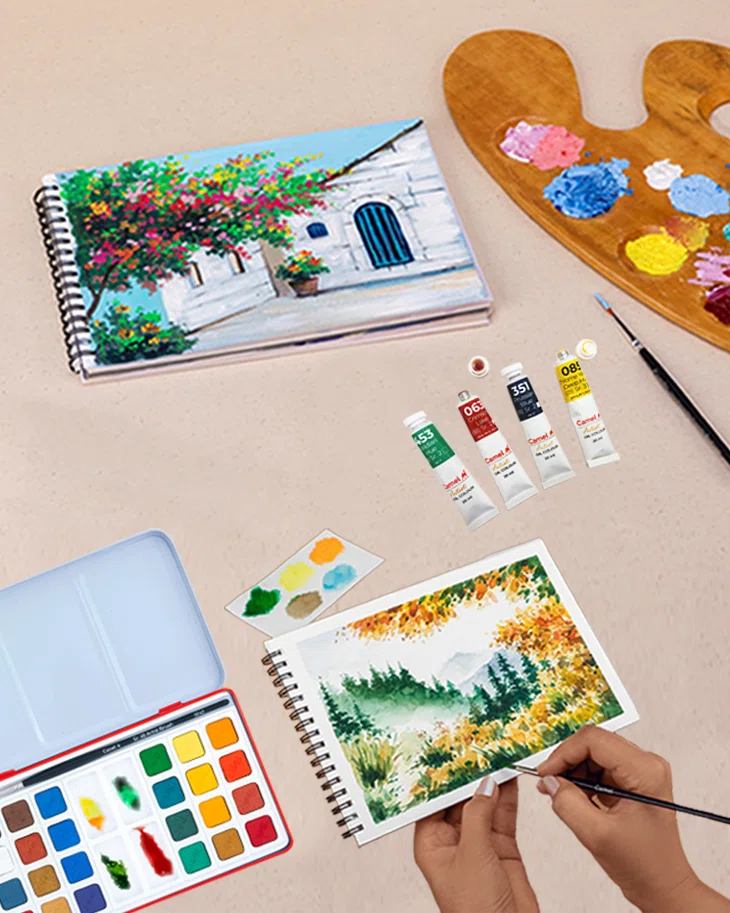People love acrylic colours because they are vibrant and dry quickly. You can paint on multiple surfaces like canvas, paper, wood, clay, or cloth. Acrylic paint turns water-resistant when it dries. You can easily clean wet paint with water, but once it dries, it won't wash away. The paint sticks firmly to the surface after drying. With so many great features, these paints are perfect for beginners. Here are 15 tips to help you start painting with acrylics:
1. Buy Good Acrylic Paints, Brushes and Mediums
Get the best paints and brushes you can. Good quality paints are vibrant, dry fast and last longer. Camel offers Acrylic Colours that are versatile and work well on many surfaces. For those focused on canvas painting, Camel Artist Acrylic Colours are specifically designed to give the best results on canvas. Both options offer high-quality results.
2. Start with Basic Brushes
Keep a few types of brushes ready. Beginners should start with a few painting brushes like a large flat brush, and a medium and a small round brush. Try more as you get better.
3. Sketch First
Use a light pencil to sketch your idea first. This step is crucial for mapping out shapes and forms, providing a guide for your paint layers. Do not stress over perfection. A sketch is just a blueprint to guide you as you paint.
4. Learn About Colours
Understanding different colours and how they blend is important. Start by working with 3 to 5 basic acrylic colours and mix complementary colours to create new shades. Add white to lighten the colours. Use complementary colours or darker shades of the same colour to create depth.
5. Understand Mediums
Gloss medium adds shine and transparency, while matte medium gives a flat finish. Camel acrylic gesso helps create textures and increase the vibrancy of applied Camel Artist Acrylic Colours. It is also used to prime unprimed surfaces like metal, plywood, or masonry. Camel Canvases come pre-primed, saving you time and effort. Work with these mediums to achieve different textures, finishes, and effects in your artwork.
6. Use Warm and Cool Shades for Contrast
Red, orange and yellow are warm colours. Blue, green and purple are cool colours. When you put warm colours next to cool colours, you add contrast to your painting. It can make things look more real and 3D. Try using both warm and cool colours in your painting.
7. Work in Layers
Acrylic paint is perfect for layering. Start with thin washes of colour and gradually build up thicker layers for added texture and depth. Each new layer enhances the details and richness of your painting. You can experiment with techniques like glazing (applying thin layers of translucent paint) or dry brushing to add texture.
8. Use More Water
Mix water with your paint to make it thinner. This can make it look like watercolours. This works best on thick and absorbent surfaces like watercolour paper as it allows the paint to settle and dry without running. You can also use water to create shadows and add textures.
9. Dab with Stiff Bristles or Paper Towels
Dab your canvas with a stiff brush or paper towel. This creates fun textures in your painting. This technique works well for abstract pieces or adding texture to specific areas like clouds.
10. Try Dry Brushing
Dry brushing involves using a dry brush to apply paint onto a dry surface. Use a dry brush with a little paint to make rough textures. It's great for painting things like rocks or tree bark. Uneven texture adds dimension to your artwork.
11. Add Details with a Fine, Wet Brush
Use a tiny wet brush to paint small details. This helps make sharp, thin lines. A wet brush holds its bristles together, allowing for sharper, more precise lines and smaller details. Use it to create intricate designs, like thin outlines or tiny highlights, that make your artwork stand out.
12. Work Relatively Fast
Acrylic paint dries fast, so try to paint fast too. If you need more time to blend, you can use retarders that slow down the drying process, allowing you to work at your own pace.
13. Keep the Paint Moist
Keeping your acrylic colours wet is essential, especially in dry climates where acrylic paint can dry out faster. Spray water intermittently on your palette to keep it from drying out. You can mix in Camel Retarder Medium to your paint, which will prevent it from drying quickly without desaturating your paint.
14. Take Care of Your Brushes
Wash your painting brushes with water after you paint. Store them standing up to keep their shape. If you take good care of your brushes, they will last longer and work smoothly for your next artwork.
15. Use Painter's Tape for Straight Lines
Stick painter's tape on your canvas to make straight lines or shapes. Paint over it, then peel it off for clean edges.
Remember, acrylic painting is fun. You can try and experiment with these tips to create textured and vibrant acrylic paintings. Do not be afraid to make mistakes. Use quality supplies like Camel Fluid Acrylic Colours and Camel Picture Varnish Spray to make amazing art.
Did this article help you learn something new?
Share your thoughts with us in the comments below.
Leave a comment

Comment added
Comment updated
Comment deleted
More inspiration
“
“The world always seems brighter when you've just made something that wasn't there before.”


